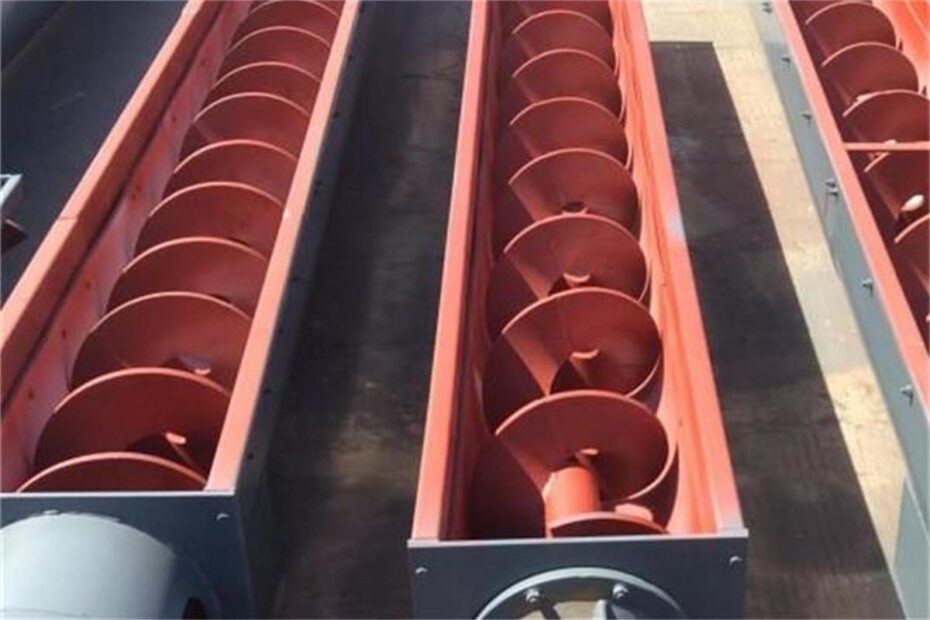Screw conveyor, commonly known as auger, is a conveying machine that uses a motor to drive the screw to rotate and push the material to achieve the purpose of conveying. Screw conveyor is suitable for short-distance horizontal, inclined or vertical conveying of powder, granular and small block materials, such as coal, ash, slag, cement, grain and other materials.
The conveying capacity of the screw conveyor depends not only on the speed of the screw shaft, but also on the shape and size of the blades and the physical properties of the material (such as particle size, density and friction coefficient, etc.). By adjusting the speed and changing the design of the blades, the needs of conveying different materials can be met.
Working principle of screw conveyor
The screw conveyor uses the rotation of the spiral blade to push the material along a specific path. The spiral blade is a spiral space curved surface. When the driving device drives the spiral core to rotate, friction is generated between the spiral blade and the material, so that the material is pushed forward.
In the horizontal or slightly inclined direction, when the screw shaft rotates, due to the material’s own gravity and the friction resistance generated by the wall of the trough, the material can only move forward along the bottom of the conveyor trough under the push of the spiral blade. The main driving force of the material comes from the force of the spiral blade to push the material upward and forward along the tangent direction of the blade when the spiral blade rotates axially.
Structural composition of the screw conveyor
It is mainly composed of a drive device, a casing, a cover plate, a spiral shaft, a spiral blade, a feed port, a discharge port and other components. The spiral blade has two rotation directions, left-handed and right-handed, and is a key component for conveying materials. The drive device is composed of a motor, a reducer, a coupling and a base, which is used to drive the spiral core to rotate.
- Spiral blades: can be divided into several forms such as full blade type, belt blade type, paddle blade type, and tooth type.
- Casing: divided into two forms: “U” type casing and circular casing. The circular casing is mainly used for sealing equipment feeding. The auger of the circular casing is also called a sealed auger.
- Spiral shaft: hollow, made of steel pipe, high strength, light weight, and easy to connect. A small section of solid shaft is used at the connection between the shafts and the installation of the bearing. At the connection, the solid shaft is inserted into the hollow shaft, and the high-strength bolts are used to penetrate the hollow shaft and the solid shaft in a mutually perpendicular direction to fix the screw shaft.
Technical features of screw conveyor
- The screw conveyor has a simple structure, is easy to operate, and is easy to maintain. It can feed and unload materials at multiple points.
- Compact size, small cross-sectional size, and small footprint. It is easy to enter and exit hatches and carriages during unloading operations at ports.
- The machine slot of the equipment has good airtightness, which is convenient for closed transportation, and is conducive to conveying materials that are easy to fly, hot, and have strong odors, which can reduce pollution to the environment and improve the working conditions of port workers.
- Easy to load and unload. The horizontal screw conveyor can be loaded and unloaded at any point on its conveying line; the vertical screw conveyor can have excellent retrieving performance by configuring a relative screw retrieving device.
- It can convey in reverse, and it can also make a conveyor convey materials in two directions at the same time, that is, toward the center or away from the center. During the conveying process, the material can also be mixed, stirred, loosened, heated, and cooled.
Conclusion
The screw conveyor has a novel structure and reliable performance, and is suitable for conveying powdered and granular materials. It is a widely used conveying equipment in the mineral, feed, grain and oil, and construction industries.

